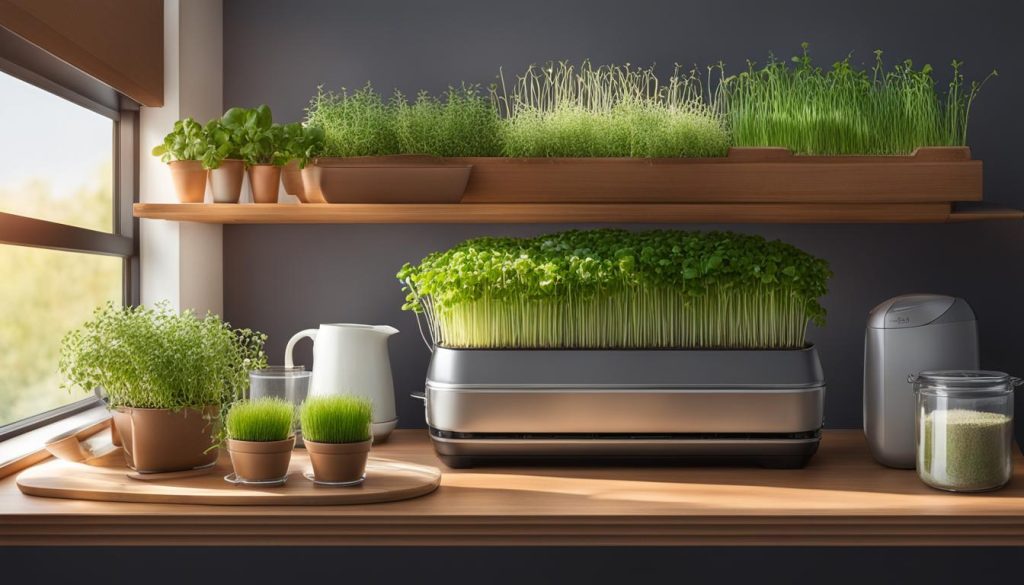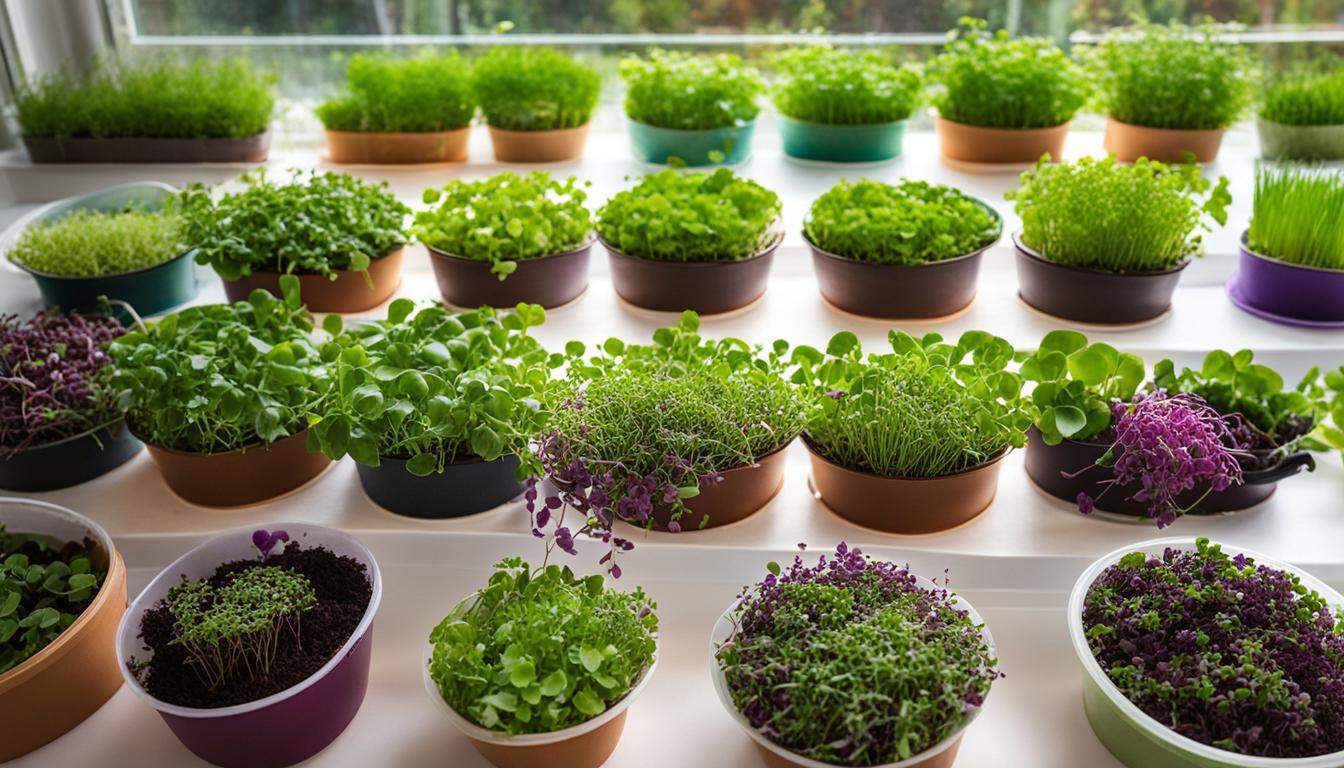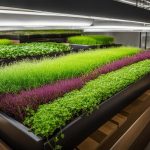Embarking on the journey of gardening can be as refreshing as the plants you grow, especially when it comes to nurturing your own lush microgreens. This comprehensive microgreens guide is your ally in the gratifying process of growing microgreens at home. With a focus on urban agriculture, we simplify how to grow microgreens so you can garnish your dining experiences with organic, nutritious, and freshly-harvested greens straight from your windowsill.
Whether you have a sprawling backyard or a cozy apartment space, microgreens farming can be tailored to fit your living arrangement, offering a quick crop cycle and an impressive boost to your daily diet. Embrace the joy of planting with ease and let’s unfold how you can turn a small corner of your home into a flourishing garden of miniature greens.
Key Takeaways
- Understand the basics of microgreens and why they are a perfect fit for urban dwellers.
- Discover the simple steps to start your own microgreens garden with minimal space.
- Learn the essentials of choosing the right seeds and soil for a successful harvest.
- Gain insights into the health benefits of adding microgreens to your diet.
- Get inspired with ideas on how to incorporate microgreens into various culinary creations.
Understanding the Basics of Microgreens Cultivation
Embarking on the journey of microgreens cultivation, enthusiasts quickly encounter the profound benefits of microgreens and their diverse applications across culinary landscapes. To truly appreciate the intricacies of microgreens farming, one must first grasp the fundamental principles underlying the growth of these vibrant plantlets.
What Are Microgreens? The Tiny Nutrient Powerhouses
Microgreens are young vegetable greens that strike a harmonious transitional stage between a sprout and a baby green. Typically harvested when they are 1–3 inches tall, these diminutive greens are sought after not only for their intense flavor profiles but also for their densely packed nutritional content, serving as potent sources of vitamins, minerals, and antioxidants.
Difference Between Microgreens and Sprouts
The gardening realm often uses ‘microgreens’ and ‘sprouts’ interchangeably, yet these two entities exhibit distinct characteristics. The most striking difference is their cultivation requirements; microgreens thrive in sunlight and nutrient-rich soil, undergoing photosynthesis, while sprouts emerge from germinated seeds that do not necessitate soil or light in their initial growth phase.
The Lifecycle of a Microgreen: From Seed to Harvest
Understanding the lifecycle of a microgreen is instrumental in achieving successful yields. The odyssey begins with the selection of quality seeds, which soon germinate and unfurl into a verdant sprawl of seed leaves, known as cotyledons. The maturation process continues with the sprouting of true leaves, signaling the approach of an optimal harvest window that promises a bounty of flavor and nutrition, fully embracing the intrinsic advantages of microgreens farming.
Benefits of Microgreens in Your Diet
Enhancing your meals with microgreens goes beyond just adding a splash of color and a subtle crunch to your favorite dishes. These tiny greens are a powerhouse of nutrition and have found their place in the pantheon of superfoods. Let’s explore how weaving microgreens into your daily diet can be beneficial and enjoyable.
Nutritional Profile: Vitamins and Minerals Galore
Packing a nutritional punch that belies their miniature size, microgreens are lauded for their nutritional benefits. Studies suggest that these tender greens contain higher levels of vitamins and minerals compared to their fully grown counterparts. From vitamin C to E and from iron to magnesium, the wide spectrum of essential nutrients found in microgreens supports a well-balanced diet and fortifies your body’s health defenses.
Culinary Uses: Enhancing Flavors in Your Dishes
When it comes to culinary creativity, enhancing flavors with microgreens has become a trendy tactic among chefs and home cooks alike. Offering a range of flavor profiles—peppery, tangy, spicy, or even sweet—microgreens can elevate a simple dish to an exciting gourmet experience. They serve not only as a garnish but as a key ingredient that complements various recipes, from smoothie bowls to artisanal sandwiches.
Health Impact: How Microgreens Can Boost Your Wellbeing
Incorporating microgreens into your diet isn’t simply a matter of following a trend; it’s about making a conscious choice towards better health. These little greens can help combat various ailments by promoting heart health, reducing the risk of chronic diseases, and providing anti-inflammatory effects. Regularly consuming microgreens can be a step towards a lifestyle that prioritizes wellbeing.
Selecting Your Microgreens – Best Varieties to Start With
Embarking on the journey of microgreen cultivation can be as rewarding as it is easy, especially when you choose the right varieties to begin with. The best microgreens to grow are often those that offer a combination of simplicity and quick harvest times, making them ideal choices for both seasoned gardeners and those new to the fold. For anyone looking at microgreens for beginners, the path to a lush harvest is just a few well-selected seeds away. Some varieties are not only straightforward to grow but also pack a punch of flavor and nutrients.
Radish microgreens, for instance, are known for their rapid growth and a spicy kick that can enhance salads and sandwiches. They thrive with minimal care, making them a top contender for your first foray into the world of microgreens. Kale, with its rich, peppery taste and high levels of vitamins, follows closely as a robust and resilient choice. Arugula, another favorite, is celebrated for its versatility and slightly nutty flavor that can elevate any dish.
While these options are fantastic for the beginner gardener, the adventurous among you might gravitate towards more exotic options. As you become more confident in your microgreen cultivation skills, you might explore varieties like purple shiso or mustard greens, which offer unique flavors and stunning colors to your microgreen repertoire.
No matter which route you choose, the satisfaction of harvesting and incorporating your homegrown greens into meals is incomparable. So start simple, and let your microgreen garden flourish as your confidence grows. The key is to begin with the best microgreens to grow and to embrace the process of nurturing your plants from seed to plate.
Growing Microgreens: The Essential Supplies You Need
Embarking on the journey of microgreens cultivation begins with gathering the right supplies. These foundational tools and materials are crucial for anyone wondering how to grow microgreens effectively. Ensuring you have the appropriate items on hand will set the stage for a successful harvest right from the comfort of your own home.
The first item on your microgreens toolkit should be a selection of suitable containers. These can range from simple nursery trays to repurposed household items, as long as they have adequate drainage. Next, invest in high-quality seeds; these are the bedrock of your microgreens farm, so sourcing them from reputable suppliers is a must.
A nutrient-rich soil or a sterile growing medium will act as the perfect bed for your seeds to sprout and flourish. While soil mediums are commonly used, some growers may opt for soilless options such as coconut coir or peat moss — the choice is yours, as long as it provides proper support and nutrition for your plants.
Equally important is your watering equipment. Microgreens require a delicate touch, so a spray bottle or a gentle watering can will ensure that you give just the right amount of moisture without overwatering and risking mold or decay.
With these items at your disposal, you’re well on your way to mastering the art of microgreens cultivation. Remember, quality supplies yield quality greens. Now that you’re equipped, let’s help you get growing!
Indoor Microgreens: Creating the Perfect Growing Environment
Bringing the lushness of microgreens into your home isn’t simply about planting seeds and waiting for them to grow. To cultivate a thriving indoor microgreens farm, one must create and maintain conditions that encourage optimal growth. From the warmth of the right lighting to the subtle balancing of humidity and temperature, let’s explore how to foster the perfect microgreen haven.

Lighting 101: Natural vs. Artificial Light for Microgreens
Light is the lifeblood of any plant, and microgreens are no exception. The choice between natural light from a sunny window and the consistency of artificial grow lights could make all the difference. While sunlight is the traditional go-to, it’s not always available or steady throughout the year. Artificial lighting, such as LED or fluorescent grow lights, offers controlled intensity and duration, making them a highly favorable option in the world of indoor microgreens farming.
Temperature and Humidity Control for Optimal Growth
The secret to lush, flavorful greens is maintaining the gentle balance of warmth and moisture. Microgreens thrive in a temperature range of 60-75°F (15-24°C) and require a consistent humidity level. A simple thermostat and humidifier can help in monitoring and adjusting the indoor climate, ensuring optimal growth conditions for microgreens. During winter or in air-conditioned rooms, be vigilant as these environments can dry out the air and affect your greens.
Troubleshooting: Common Issues with Indoor Microgreens Farming
Even with the right settings, challenges like mold or uneven germination might arise, potentially discouraging the novice grower. Combating these issues requires good air circulation, proper watering techniques, and clean growing practices. Remember, vigilance and quick response are key to keeping your microgreen garden healthy. If you notice any signs of distress, address them immediately to prevent them from escalating, keeping your journey in microgreens farming smooth and rewarding.
Microgreens for Beginners: Step-by-Step Sowing Instructions
Embarking on the journey of how to grow microgreens can be an exhilarating adventure. To set you on a path toward a flourishing microgreen garden, we’ve crafted a clear, step-by-step microgreens guide that’s perfect for those new to this growing trend. Let’s start with the absolute basics, ensuring that microgreens for beginners doesn’t seem like a daunting endeavor.
The first step is to prepare your growing tray or container with a layer of pre-moistened, fine-textured, and nutrient-rich soil. The soil should be firm but not compacted, creating an even surface for your seeds. Next, sprinkle the seeds evenly across the soil, aiming for a dense but not overcrowded distribution, as it will provide ample space for each microgreen to thrive.
Once seeded, gently press them into the soil without burying them deeply. A light covering of soil can be used for larger seeds, but for most microgreens, simply pressing them into the soil will suffice. The magic begins with proper watering—use a misting bottle to lightly moisten the seeds without causing erosion. This step is crucial to kickstart the germination process.
Now, it’s all about creating the right environment. Cover your tray with another inverted tray or a light cloth to maintain humidity and darkness during germination. Monitor daily and mist as needed to keep the seeds moist. After a few days, once you notice sprouts emerging, it’s time to introduce them to light. Whether you are using natural sunlight or an artificial grow light, ensure your microgreens receive enough light without getting scorched.
Consistency is key in watering your microgreens. They need to stay hydrated but not waterlogged. A simple routine that ensures even moisture will support your microgreens as they grow. Remember, patience and close observation during these stages will provide you with insights for future growth cycles.
By following this step-by-step microgreens guide, even novice growers can expect to see their tiny greens flourish ready for harvest in just a few weeks. Sowing microgreens is just the beginning of a rewarding venture into micro-farming right on your windowsill or kitchen counter.
The Importance of Organic Microgreens and How to Ensure Purity
As the demand for healthful eating options continues to grow, organic microgreens are emerging as a potent symbol of both nutrition and environmental consciousness. These tiny greens are not only a burst of flavor and vitality on the plate but also a statement of commitment to food safety and sustainability. Organic microgreens offer a way to enjoy greens without the worry of chemical contaminants.
Why Organic Matters: Avoiding Contaminants in Your Microgreens
The thrust towards organic agriculture is primarily driven by the desire to sidestep the potentially harmful effects of pesticides and fertilizers found in conventional farming practices. Ensuring organic purity in microgreens is crucial as their delicate structures can easily absorb and concentrate any chemicals used during growth. By trusting in organic methods, you reassure not only the wholesomeness of your diet but also support the wellbeing of the ecosystem.
Sourcing Organic Seeds and Soil
To start your microgreens on a genuine organic foundation, sourcing certified organic seeds and soil is a pivotal step. Using products that are guaranteed to be free from synthetic additives reinforces the organic promise from the very beginning, laying a pristine groundwork for your microgreens. It also supports organic farming industries committed to holistic, sustainable, and pesticide-free agricultural methods.
Homemade vs. Store-Bought Organic Fertilizers
The debate between using homemade versus store-bought organic fertilizers is a testament to the desire for alignment with nature’s rhythms. Homemade organic fertilizers, such as compost teas or worm castings, provide not only essential nutrients but also a rewarding DIY aspect to the practice of growing microgreens. Alternatively, store-bought organic fertilizers offer convenience and precision. Regardless of the choice, proper application is key to support the robust growth of your organic microgreens and ensure they reach their nutritional peak.
Maintaining Your Microgreens: Watering and Nutrient Schedules
Growing microgreens has become a favorite pastime for food enthusiasts and gardeners alike. Yet, an absolute key to success lies in understanding the nuances of maintaining microgreens. This involves more than just letting them grow; it expresses a delicate balance of watering, providing nutrients, and harvesting at the precise time.
Understanding the Water Needs of Microgreens
To ensure the health of your microgreens, consider their water requirements that hinge on the species and the stage of growth. Generally, the preferred method is to mist or bottom-water the plants, preventing the fragile shoots from being weighed down by heavy water droplets. Over-watering can be as detrimental as under-watering, leading to conditions such as mold and mildew, which are unforgiving to your tender greens.
Feeding Your Microgreens: When and How
Microgreens are often described as less demanding when it comes to nutrition due to their short life cycle, but this doesn’t mean they’ll forgo a good meal. It’s important to adhere to nutrient schedules for microgreens, which typically involve adding a diluted solution of liquid fertilizer rich in micronutrients to the water after the seeds have fully germinated. This gives them a necessary boost to develop lush, tasty leaves.
Harvesting Techniques to Maximize Yield and Flavor
Finally, harvesting microgreens is both art and science. It requires timing and technique to ensure the highest yield and best flavor. Harvesting should be done when the first true leaves begin to unfurl, using a sharp knife or scissors to cut the stems cleanly above the soil line. For some varieties, you may even encourage a second growth, granting a sustained supply of these delightful greens. By mastering these aspects, you’ll enjoy microgreens that don’t just survive, they thrive, making each meal they enhance richer for the effort.
How to Grow Microgreens: Advanced Tips for Seasoned Growers
For those seasoned microgreen growers looking to push the boundaries of their green thumbs, exploring the frontier of advanced microgreens cultivation tips can elevate your harvest to professional levels. Advances in horticultural techniques have opened up new possibilities for enthusiasts ready to experiment with more sophisticated methods.
One such high-yield approach involves the use of hydroponic systems. These soil-less wonders allow for precise control over the nutrient intake of your microgreens, producing cleaner plants and eliminating many of the pests and diseases commonly found in soil. By fine-tuning the pH levels and nutrient densities, growers can coax out robust flavors and intensified colors in their crops.
Additionally, the implementation of crop rotation within your cultivation space ensures that soil nutrients are kept in balance and reduces the build-up of pathogens that might otherwise impact plant health. Taking the time to rotate crops can lead to more sustainable growth cycles and a rich variety of harvests throughout the year.
Keen to enhance the diversity of your indoor garden? Experience the thrill of discovery by incorporating a dynamic range of microgreen varieties into your repertoire. Seek out rare or exotic seeds to challenge your skills and delight your palate. As your indoor garden evolves, so too will your expertise, leaving you with a multitude of beautiful, tasty, and nutritious greens at your fingertips.
With these advanced cultivation methods, the sky is truly the limit for creating a microgreens paradise. Your commitment to advancing your skills not only brings a harvest of delectable greens but also stands as a testament to the marvels of growth and innovation in the microgreens industry.
Conclusion
As we now understand, the journey of nurturing microgreens indoors unravels a rewarding experience that culminates in the enhancement of our meals and overall well-being. The simplicity of the process, paired with the considerable benefits of microgreens, creates a satisfying venture that extends beyond basic gardening into a meaningful practice of cultivating health. By infusing your dishes with these verdant treasures, you not only elevate the dining experience but also embrace a lifestyle enriched with vital nutrients. The intimate connection fostered with what you eat is a sentiment unmatched, bringing us closer to the origins of our food.
Reaping the Rewards: Enjoying Your Home-Grown Microgreens
Indulging in the fresh zest of home-grown microgreens is not merely about savoring their flavor but also about reveling in their health benefits. These leafy gems pack a punch of vitamins and minerals that fortify your diet with essential nutrients. The satisfaction derived from adding these self-cultivated greens to your culinary creations embodies the purest form of farm-to-fork, and every bite serves as a reminder of your dedication to wellness and self-sufficiency.
Expanding Your Indoor Garden: Next Steps After Mastering Microgreens
With the foundational knowledge and confidence gained from growing microgreens, the natural progression leads to expanding your indoor microgreens garden. As you venture beyond the basics, consider diversifying your array of greens or delving into more intricate cultivation methods. Integrating advanced growing systems or exploring new varietals brings about a continuous learning curve and an evolving practice that keeps the urban gardener engaged. There’s a universe of possibilities awaiting those ready to broaden their horticultural horizons, sowing the seeds for a greener, more sustainable future within their own homes.


